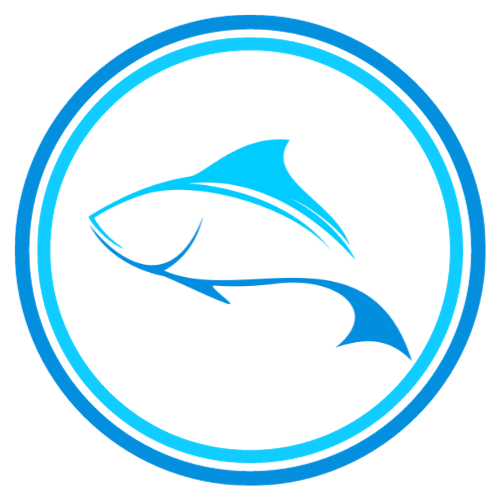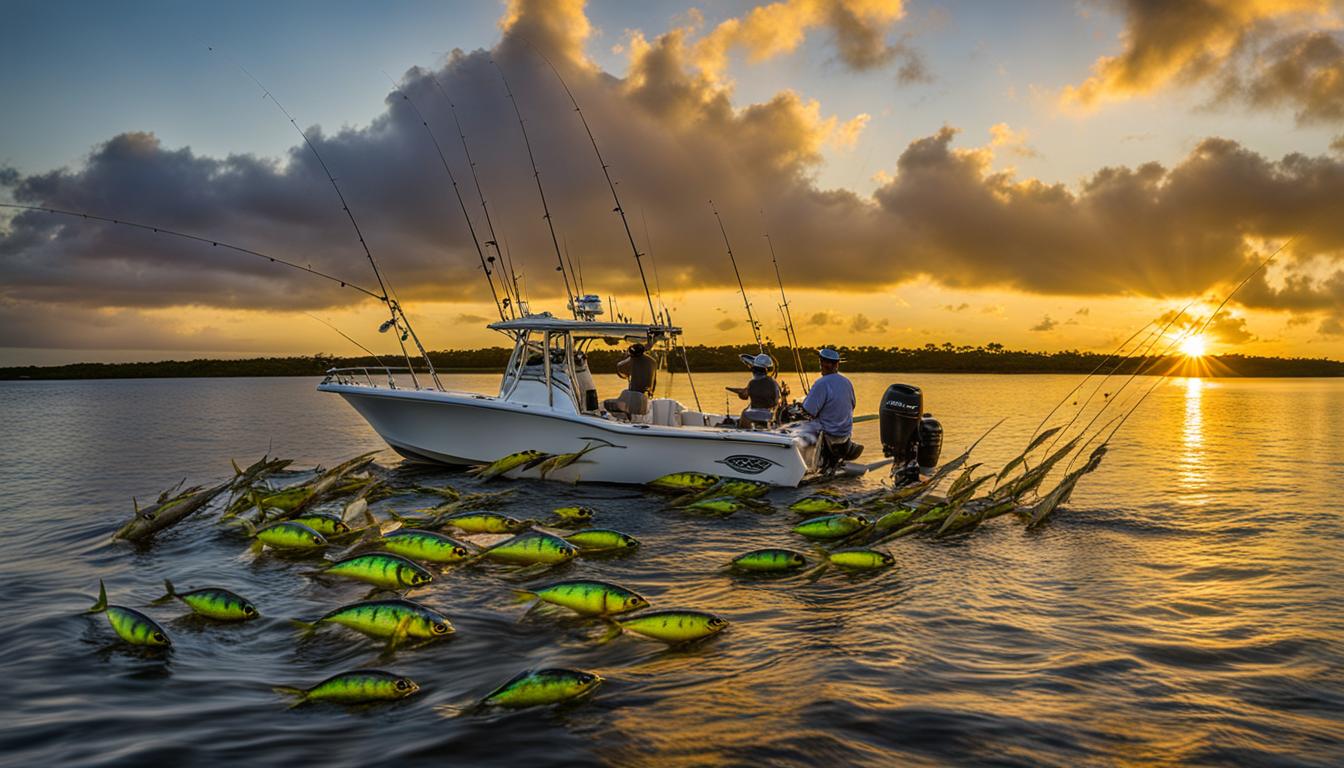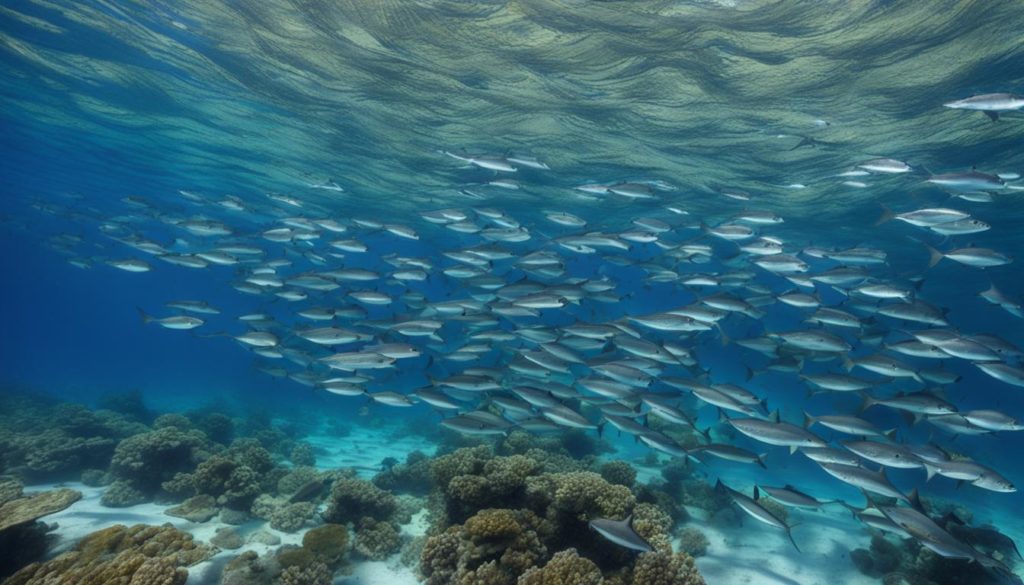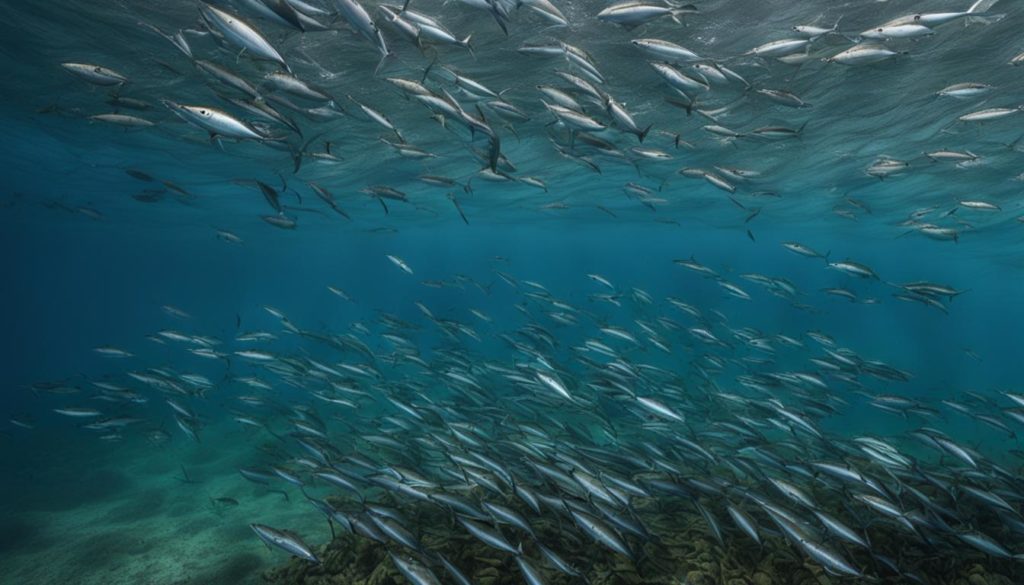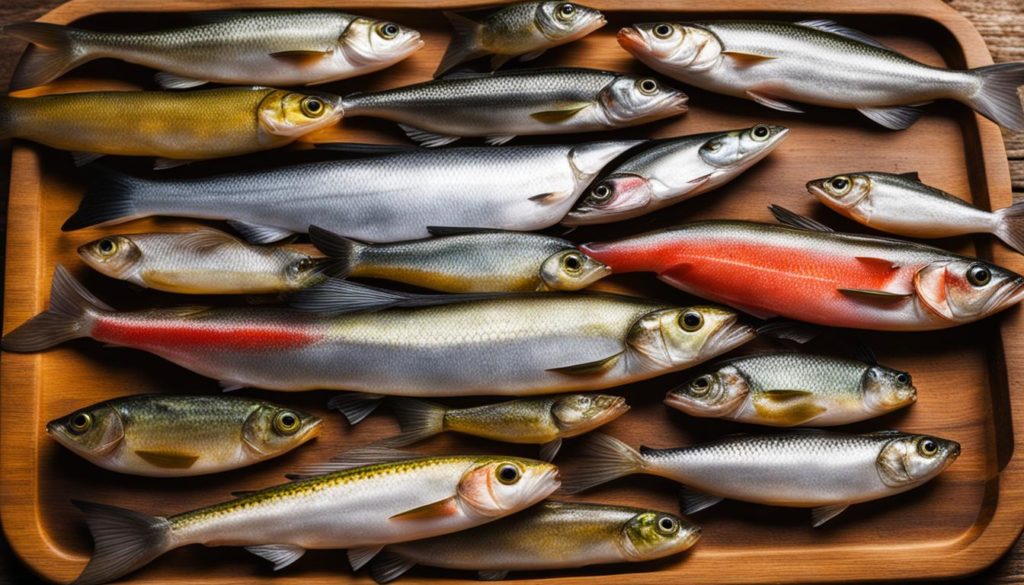When it comes to saltwater fishing in Florida, having the right bait can make all the difference. With so many options available, it can be overwhelming to choose the best bait for your fishing adventure. That’s why we’ve compiled a list of the top 10 baits that have proven to be highly effective in Florida’s saltwater. Whether you’re targeting redfish, snook, or trout, these baits have been successful in attracting and catching a wide variety of saltwater fish.
Our Florida saltwater fishing bait guide will help you make informed decisions and increase your chances of a successful catch. From live bait to artificial lures, we’ll cover it all. So, grab your fishing gear and let’s dive into the world of the best bait for Florida saltwater fishing!
Key Takeaways:
- Choosing the right bait is crucial for successful saltwater fishing in Florida.
- The top 10 best bait options include shrimp, ballyhoo, pilchards, greenies, cut bait, crabs, sand fleas, artificial lures, squid, and lobsters.
- Each bait has its own unique advantages and attracts different species of saltwater fish.
- Experimenting with different baits can help you find what works best in your fishing location and target species.
- Remember to check local regulations and restrictions before using certain baits or lures.
Shrimp: A Versatile and Effective Bait for Florida Saltwater Fishing
When it comes to saltwater fishing in Florida, one bait stands out for its versatility and effectiveness: shrimp. Whether you’re targeting redfish, snook, or trout, shrimp can be a game-changer. It’s readily available, both live and frozen, making it accessible to anglers of all levels. The natural scent and lifelike movement of shrimp make it irresistible to many saltwater fish species.
To maximize your chances of success, shrimp can be presented on various rigs, such as a Carolina rig or a jighead. Depending on your target fish and the fishing conditions, shrimp can be fished near the bottom or suspended under a popping cork. Its versatility allows you to adapt your approach to different fishing situations and increase your chances of a successful catch.
Using shrimp as bait for saltwater fishing in Florida is not only effective but also convenient. It’s a bait that fish are naturally attracted to, ensuring that you’ll have action on your line. Whether you’re a seasoned angler or a beginner, shrimp is a reliable and proven bait option that can help you reel in that trophy fish.
Benefits of Using Shrimp as Bait:
- Highly versatile bait that can target a wide range of saltwater fish species
- Readily available, both live and frozen
- Natural scent and lifelike movement attract fish
- Can be presented on various rigs, allowing for adaptation to different fishing conditions
- Proven effectiveness in Florida saltwater fishing
“Shrimp is a highly versatile and effective bait for saltwater fishing in Florida. Its natural scent and lifelike movement make it irresistible to many saltwater fish.” – Expert Angler
| Species | Best Time to Use Shrimp | Common Techniques |
|---|---|---|
| Redfish | Morning and evening | Carolina rig, jighead |
| Snook | Low light conditions | Popping cork, jighead |
| Trout | Throughout the day | Jighead, free-lined |
Ballyhoo: A Top Bait Choice for Florida Saltwater Fishing
The waters of Florida are teeming with a variety of saltwater fish species, and choosing the right bait is essential for a successful fishing trip. When it comes to offshore fishing, ballyhoo is a top choice among anglers. This versatile and effective bait is known for its ability to attract pelagic species such as mahi-mahi, sailfish, and wahoo. Whether trolling behind a boat or rigging it as live bait, ballyhoo can enhance your chances of landing a trophy catch.
Ballyhoo’s long, slender body and realistic swimming motion make it irresistible to predatory fish. Its bright colors and lifelike appearance mimic the natural prey of many saltwater species, triggering strikes from hungry predators. When used as cut bait for bottom fishing, ballyhoo can attract a wide variety of fish, making it a versatile option for anglers.
Benefits of Using Ballyhoo as Bait
There are several key reasons why ballyhoo is a preferred bait choice for Florida saltwater fishing:
- Attractive Swimming Motion: Ballyhoo’s natural swimming motion and realistic appearance make it highly enticing to predatory fish.
- Versatility: Ballyhoo can be used for both offshore and bottom fishing, making it a versatile bait option.
- Availability: Ballyhoo is readily available at bait and tackle shops, both fresh and frozen, making it easily accessible to anglers.
- Success Rates: Anglers have reported high success rates using ballyhoo as bait, especially when targeting pelagic species.
So, the next time you head out for a saltwater fishing adventure in Florida, consider using ballyhoo as your bait of choice. Its natural swimming motion, lifelike appearance, and versatility make it a top contender for attracting a wide range of saltwater fish species. Experiment with different presentations, such as trolling or rigging as live bait, to optimize your chances of a memorable catch.
Pilchards: A Versatile and Effective Bait for Florida Saltwater Fishing
When it comes to saltwater fishing in Florida, one bait option that stands out is pilchards. Also known as scaled sardines, pilchards have gained popularity among anglers for their versatility and effectiveness in attracting saltwater fish. Whether you’re targeting snook, tarpon, or kingfish, pilchards are a bait you shouldn’t overlook.
One of the key advantages of using pilchards as bait is their irresistible scent and natural movement. The oily scent of pilchards acts as a powerful attractant for many saltwater fish species, drawing them in from a distance. Additionally, pilchards have a lifelike swimming motion that mimics the natural movement of prey, making them highly appealing to predatory fish.
Pilchards can be presented in various ways depending on your fishing technique and target species. They can be fished live or used as cut bait, giving you flexibility in your approach. Live pilchards can be threaded onto a hook or presented on a weighted hook, while cut pilchards can be used on a fish finder rig or a Carolina rig.
When using pilchards as bait, it’s important to consider the fishing location and the preferences of the target species. For example, if you’re fishing near inshore structures like docks or bridges, the movement and scent of pilchards can attract snook and other predatory fish. On the other hand, if you’re offshore targeting pelagic species, such as mahi-mahi or sailfish, trolling rigged pilchards can be highly effective.
Table: Comparison of Pilchards as Bait for Florida Saltwater Fishing
| Pilchards as Bait | Advantages |
|---|---|
| Versatile | Pilchards can be used live or as cut bait, giving anglers flexibility in their presentation. |
| Effective Scent | The oily scent of pilchards acts as a powerful attractant for many saltwater fish species. |
| Natural Movement | Pilchards have a lifelike swimming motion that mimics the natural movement of prey. |
| Target Species | Pilchards are effective for targeting a variety of saltwater fish species, including snook, tarpon, and kingfish. |
- Pilchards are versatile bait that can be used live or as cut bait.
- The oily scent of pilchards is highly attractive to many saltwater fish species.
- Pilchards have a lifelike swimming motion that mimics natural prey.
- They are effective for targeting snook, tarpon, and kingfish, among other species.
“Using pilchards as bait has significantly increased my success in Florida saltwater fishing. The scent and movement of pilchards attract a wide range of fish, and they are easy to use in different fishing techniques. Whether I’m fishing inshore or offshore, pilchards have proven to be a reliable choice for maximizing my catch.” – Experienced angler
Greenies: A Versatile Bait Choice for Florida Saltwater Fishing
If you’re looking for a versatile and effective bait for saltwater fishing in Florida, look no further than greenies, also known as threadfin herring. Greenies are a popular choice among anglers for targeting predatory species such as snook, tarpon, and kingfish. These baitfish can be fished live or used as cut bait, offering flexibility depending on your fishing style and target species.
What makes greenies so effective is their shimmering scales and enticing movement, which imitate the natural prey of predatory fish. Whether you’re fishing inshore near structures like docks and bridges or offshore in search of larger game fish, greenies can attract fish from a distance.
Greenies are often found near inshore structures, making them easily accessible bait for anglers. Their availability and popularity among predatory species make greenies a must-have bait in your tackle box when heading out for saltwater fishing in Florida. So grab some greenies, hit the water, and get ready for an exciting day of fishing!
Benefits of Using Greenies for Saltwater Fishing in Florida
- Attracts a wide range of predatory species including snook, tarpon, and kingfish
- Shimmering scales and lifelike movement imitate natural prey, triggering strikes
- Easily accessible near inshore structures such as docks and bridges
- Can be fished live or used as cut bait depending on fishing style and target species
Expert Tip: Rigging Greenies for Maximum Effectiveness
When rigging greenies, consider using a circle hook for catch-and-release fishing. Circle hooks are designed to prevent deep hooking, increasing the chances of a successful release. Simply hook the greenie through the lips or nose, and let the circle hook do its job when the fish takes the bait.
Table: Comparison of Greenies and Other Bait Options
| Bait Option | Target Species | Fishing Style | Availability |
|---|---|---|---|
| Greenies | Snook, Tarpon, Kingfish | Inshore and Offshore | Easily accessible near inshore structures |
| Shrimp | Redfish, Snook, Trout | Inshore | Readily available, both live and frozen |
| Ballyhoo | Mahi-Mahi, Sailfish, Wahoo | Offshore | Commonly available for offshore fishing |
| Pilchards | Snook, Tarpon, Kingfish | Inshore and Offshore | Highly effective and popular bait choice |
Cut Bait: An Effective Choice for Saltwater Fishing in Florida
If you’re looking for a versatile and effective bait option for saltwater fishing in Florida, look no further than cut bait. Using cut bait can greatly increase your chances of catching a wide range of saltwater fish species in the Sunshine State.
So, what exactly is cut bait? Cut bait refers to any type of fish that has been cut into smaller pieces and used as bait. Common types of cut bait used in Florida saltwater fishing include mullet, ladyfish, and mackerel. These oily and aromatic baits release a strong scent that attracts predatory fish, helping to lure them in and trigger strikes.
One of the great advantages of using cut bait is its versatility. Cut bait can be fished on a variety of rigs, such as a fish finder rig or a Carolina rig, allowing you to adapt to different fishing conditions and target different species. Whether you’re fishing from a boat or from the shore, cut bait can be an effective choice.
Advantages of using cut bait for saltwater fishing in Florida:
- Strong scent: The natural scent of cut bait is highly attractive to saltwater fish, especially predatory species.
- Versatility: Cut bait can be presented on various rigs, allowing you to adapt to different fishing conditions and target different species.
- Availability: Fish used for cut bait, such as mullet and mackerel, are commonly found in Florida waters, making them easily accessible for anglers.
When using cut bait, it’s important to properly prepare and present the bait. Ensure that the pieces of cut bait are fresh and securely attached to your rig. Experiment with different sizes and shapes of cut bait to see what works best for the species you’re targeting.
Next time you head out for a saltwater fishing adventure in Florida, consider using cut bait as your bait of choice. Its strong scent and natural presentation can entice a wide range of saltwater fish, increasing your chances of a successful catch.
Table: Pros and Cons of Using Cut Bait for Saltwater Fishing in Florida
| Pros | Cons |
|---|---|
| Strong scent attracts predatory fish | Requires preparation and cutting of bait |
| Versatile and can be used with different rigs | May require fresh bait for optimal effectiveness |
| Common fish used for cut bait are readily available in Florida waters | Can be messy to handle and store |
Crabs: A Versatile and Effective Bait for Florida Saltwater Fishing
When it comes to saltwater fishing in Florida, using crabs as bait can greatly enhance your chances of a successful catch. Crabs are a natural prey for many saltwater fish species found in Florida’s waters, making them an excellent choice for anglers looking to attract and entice a variety of targets.
There are different types of crabs that can be used for saltwater fishing, such as blue crabs and fiddler crabs. Each variety has its own unique characteristics and can be utilized based on the specific target fish species and fishing location.
One of the advantages of using crabs as bait is their natural movement and scent, which imitate the behavior of prey in the water. This makes them highly attractive to predatory fish, enticing them to strike. Whether you choose to present the crab on a crab trap or a weighted hook, the lifelike movement of the crab will create a realistic and irresistible bait presentation.
Next time you head out for a saltwater fishing adventure in Florida, consider adding crabs to your bait arsenal. Their versatility and effectiveness as bait make them a valuable asset in increasing your chances of catching a variety of saltwater fish species.
| Type of Crab | Target Fish Species | Fishing Location |
|---|---|---|
| Blue Crabs | Redfish, black drum, sheepshead | Inshore structures, such as mangroves, docks, and oyster bars |
| Fiddler Crabs | Pompano, black drum, flounder | Sandy flats, nearshore sandbars |
Sand Fleas: A Powerful Bait for Florida Saltwater Fishing
When it comes to saltwater fishing in Florida, one bait that should not be overlooked is sand fleas. These small crustaceans, also known as mole crabs, are highly effective at attracting a variety of saltwater fish species. Whether you are surf fishing along the sandy beaches or casting near the shoreline, sand fleas can significantly increase your chances of a successful catch.
What makes sand fleas such a powerful bait is their natural appeal to predatory fish. Their movement and scent imitate the behavior of the fish’s natural prey, triggering an instinctive response. This makes sand fleas irresistible to species such as pompano, whiting, and flounder, which frequently feed on these small creatures.
Using sand fleas as bait is relatively straightforward. They can be fished live or as cut bait, depending on your preference. If using them live, simply thread them onto a hook using a bait threader, ensuring they are secured properly. If opting for cut bait, divide the sand fleas into smaller pieces and place them on a hook. Both methods can be effective, so it’s worth experimenting to see which one yields the best results for your fishing location.
Artificial Lures for Florida Saltwater Fishing
When it comes to saltwater fishing in Florida, using artificial lures can be a highly effective and exciting approach. Artificial lures are designed to mimic the appearance and movement of natural prey, making them irresistible to saltwater fish. They come in a wide variety of types, sizes, and colors, allowing anglers to tailor their choice to the target species and fishing conditions.
One popular type of artificial lure is the soft plastic bait. Soft plastics are made of flexible materials and often imitate baitfish, shrimp, or crabs. They can be rigged on a weighted jighead or used with a Carolina rig for bottom fishing. The lifelike action and scent of soft plastics make them particularly effective for attracting predatory fish.
Another commonly used artificial lure is the hard bait, which can include crankbaits, jerkbaits, and topwater plugs. Hard baits are typically made of durable materials and have realistic finishes and swimming actions. They can be retrieved at various speeds and depths to imitate the movement of injured or fleeing prey, enticing fish to strike.
Topwater lures are an exciting choice for anglers looking to create surface commotion and elicit explosive strikes. They imitate injured baitfish or frogs and are retrieved in a way that causes them to splash, pop, or walk across the water’s surface. Topwater lures are especially effective for targeting species such as snook, redfish, and tarpon.
When using artificial lures in Florida saltwater fishing, it’s important to consider the water clarity, current, and the behavior of the target species. Experimenting with different lure types, sizes, and colors can help you determine what works best in the specific fishing location and conditions. Remember to vary your retrieve speed and technique to trigger strikes from different fish.
Conclusion
In conclusion, Florida offers anglers a plethora of bait options for saltwater fishing. The top 10 best bait choices for Florida saltwater fishing include shrimp, ballyhoo, pilchards, greenies, cut bait, crabs, sand fleas, artificial lures, squid, and lobsters. Each bait has its own unique advantages and attracts different species of saltwater fish. Whether you choose live bait or artificial lures, experimenting with different baits can help you find what works best in your fishing location and target species.
When it comes to saltwater fishing in Florida, it’s important to consider the specific fish species you’re targeting and the fishing conditions. Different baits excel in different situations, so it’s worth having a variety on hand. Live baits like shrimp and pilchards are versatile and effective for a wide range of saltwater fish, while artificial lures offer endless possibilities for customization and presentation.
Remember to match your bait choice to the fish’s natural prey and mimic their movements as closely as possible. Pay attention to the scent, appearance, and action of your bait to maximize your chances of success. Each bait has its own strengths and weaknesses, so don’t be afraid to try new things and see what works best for you. With the right bait selection and some strategic fishing techniques, you can increase your chances of landing a trophy catch in the beautiful waters of Florida.
FAQ
What are the best bait options for saltwater fishing in Florida?
The top 10 best bait options for saltwater fishing in Florida are shrimp, ballyhoo, pilchards, greenies, cut bait, crabs, sand fleas, artificial lures, squid, and lobsters.
Which fish species can be caught using shrimp as bait in Florida?
Shrimp can be used to target a wide range of saltwater fish species in Florida, including redfish, snook, and trout.
What is the best way to present shrimp as bait for saltwater fishing in Florida?
Shrimp can be presented on a variety of rigs, such as a Carolina rig or a jighead. It can be fished near the bottom or suspended under a popping cork.
What types of fish can be caught using ballyhoo as bait in Florida?
Ballyhoo is commonly used for targeting pelagic species such as mahi-mahi, sailfish, and wahoo in offshore saltwater fishing in Florida.
How can ballyhoo be used as bait in Florida saltwater fishing?
Ballyhoo can be trolled behind a boat or rigged as live bait on a hook. It can also be used as cut bait for bottom fishing, attracting a variety of species.
What species can be targeted using pilchards as bait in Florida?
Pilchards are highly effective bait for targeting species such as snook, tarpon, and kingfish in both inshore and offshore saltwater fishing in Florida.
How can pilchards be presented as bait for saltwater fishing in Florida?
Pilchards can be presented on a variety of rigs, such as free-lined bait or with a weighted hook. Their oily scent and natural movement make them irresistible to many saltwater fish.
What types of fish can be caught using greenies as bait in Florida?
Greenies, also known as threadfin herring, are commonly used for targeting predatory species such as snook, tarpon, and kingfish in Florida saltwater fishing.
How can greenies be fished as bait in Florida saltwater fishing?
Greenies can be fished live or as cut bait. They are often found near inshore structures, such as docks and bridges, making them easily accessible bait.
What is cut bait and how can it be used for saltwater fishing in Florida?
Cut bait refers to any type of fish that has been cut into smaller pieces and used as bait. It can be used for bottom fishing in Florida’s saltwater. Common types of cut bait include mullet, ladyfish, and mackerel.
Which fish species can be targeted using crabs as bait in Florida?
Crabs are a natural prey for many saltwater fish species in Florida, making them an excellent bait choice. They can be used to target a variety of species.
How can crabs be presented as bait for saltwater fishing in Florida?
Crabs can be presented on a variety of rigs, such as a crab trap or a weighted hook. Their movement and scent imitate natural prey, attracting predatory fish.
What types of fish can be caught using sand fleas as bait in Florida?
Sand fleas, also known as mole crabs, are commonly used for targeting species such as pompano, whiting, and flounder in surf fishing in Florida.
How can sand fleas be used as bait for saltwater fishing in Florida?
Sand fleas can be fished live or as cut bait. They are often threaded onto a hook using a bait threader and are highly effective at attracting fish in the surf zone.
What are the different types of artificial lures used for saltwater fishing in Florida?
Artificial lures come in a wide variety of types, including soft plastics, hard baits, and topwater lures. Some popular artificial lures for saltwater fishing in Florida include spoons, jigs, swimbaits, and plugs.
How can artificial lures be used for saltwater fishing in Florida?
Artificial lures can imitate various types of prey, attracting predatory fish. The choice of lure will depend on the target species and fishing conditions.
